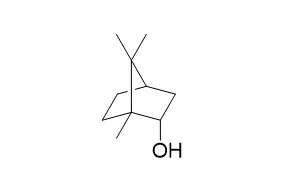| In vitro: |
| Biochemical Pharmacology, 2005, 69(7):1101-1111. | | (+)- And (-)-borneol: efficacious positive modulators of GABA action at human recombinant alpha1beta2gamma2L GABA(A) receptors.[Pubmed: 15763546] | (+)-Borneol is a bicyclic monoterpene used for analgesia and anaesthesia in traditional Chinese and Japanese medicine and is found in the essential oils of medicinal herbs, such as valerian.
(+)-Borneol was found to have a highly efficacious positive modulating action at GABA(A) receptors, as did its enantiomer (-)-borneol.
METHODS AND RESULTS:
The effects of these bicyclic monoterpenes alone and with GABA were evaluated at recombinant human alpha(1)beta(2)gamma(2L) GABA(A) receptors expressed in Xenopus laevis oocytes using two-electrode voltage-clamp electrophysiology. (+)-Borneol (EC(50) 248microM) and (-)-borneol (EC(50) 237microM) enhanced the action of low concentrations of GABA by more than 1000%. These enhancing effects were highly dependent on the relative concentrations of the borneol enantiomer and GABA, and were insensitive to flumazenil indicating that (+)- and (-)-borneol were not acting at classical benzodiazepine sites. The maximal responses to GABA were enhanced 19% by (+)-Borneol and reduced 21% by (-)-borneol. The borneol analogues isoborneol, (-)-bornyl acetate and camphor, produced less marked effects. At high concentrations (>1.5mM) (+)- and (-)-borneol directly activated GABA(A) receptors producing 89% and 84%, respectively, of the maximal GABA response indicative of a weak partial agonist action. Although of lower potency, the highly efficacious positive modulatory actions of (+)- and (-)-borneol on GABA responses were at least equivalent to that of the anaesthetic etomidate and much greater than that of diazepam or 5alpha-pregnan-3alpha-ol-20-one.
CONCLUSIONS:
The relatively rigid cage structure of these bicyclic monoterpenes and their high efficacy may aid in a greater understanding of molecular aspects of positive modulation of the activation of GABA(A) receptors. |
|
| In vivo: |
| Molecular Medicine Reports, 2017, 15(6):4239. | | Different effects of (+)‑borneol and (‑)‑borneol on the pharmacokinetics of osthole in rats following oral administration.[Pubmed: 28440419] | Osthole is the primary active component of a number of herbal plants such as the Cnidium monnieri fruit. In traditional Chinese herb medicine, osthole is commonly used in combination with borneol to obtain improved pharmacological effects. The aim of the present study was to investigate the effect of borneol enantiomers on the pharmacokinetics of osthole.
METHODS AND RESULTS:
An appropriate high‑performance liquid chromatography (HPLC) method was applied to determine the concentrations of osthole in plasma. Following oral administration of osthole alone or combined with borneol in rats, blood samples were collected and analyzed by HPLC. The results demonstrated that there were statistically significant differences in the pharmacokinetic parameters of osthole between osthole administration alone and co‑administration with borneol. When combined with synthetic borneol, the AUC0‑t, AUC0‑∞ and Cmax of osthole increased by 48.153, 104.708 and 92.630%, respectively, while the CL/F decreased by 51.251%. When combined with (+)‑borneol, the AUC0‑t, AUC0‑∞ and Cmax of osthole were increased by 61.561, 78.167, and 51.769%, respectively, while the CL/F decreased by 44.174% (P<0.01). In addition, when combined with (-)-Borneol, the AUC0‑t, AUC0‑∞ and Cmax of osthole increased by 115.856, 167.786 and 271.289%, respectively, while the CL/F decreased by 60.686% (P<0.01).
CONCLUSIONS:
These results indicated that borneol may enhance gastrointestinal absorption and inhibit the metabolism of osthole. In addition, the promotional effect of (-)-Borneol on the pharmacokinetic parameters of osthole was greater than that of (+)‑borneol. |
|






 Cell. 2018 Jan 11;172(1-2):249-261.e12. doi: 10.1016/j.cell.2017.12.019.IF=36.216(2019)
Cell. 2018 Jan 11;172(1-2):249-261.e12. doi: 10.1016/j.cell.2017.12.019.IF=36.216(2019) Cell Metab. 2020 Mar 3;31(3):534-548.e5. doi: 10.1016/j.cmet.2020.01.002.IF=22.415(2019)
Cell Metab. 2020 Mar 3;31(3):534-548.e5. doi: 10.1016/j.cmet.2020.01.002.IF=22.415(2019) Mol Cell. 2017 Nov 16;68(4):673-685.e6. doi: 10.1016/j.molcel.2017.10.022.IF=14.548(2019)
Mol Cell. 2017 Nov 16;68(4):673-685.e6. doi: 10.1016/j.molcel.2017.10.022.IF=14.548(2019)